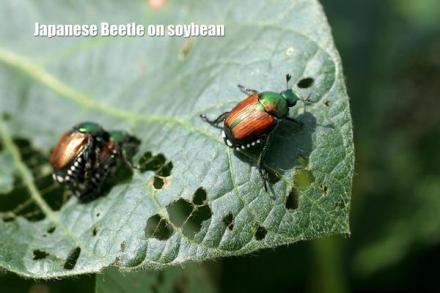 They’re baaaaccck!! That’s right, the Japanese beetles are back. What exactly is a Japanese beetle and why should we be concerned? Knowing a little bit about these tiny terrors will help keep your landscape from becoming their next meal.
They’re baaaaccck!! That’s right, the Japanese beetles are back. What exactly is a Japanese beetle and why should we be concerned? Knowing a little bit about these tiny terrors will help keep your landscape from becoming their next meal.
This beetle is related to some of the other common pests we see. The Japanese beetle is related to the May/June beetle & masked chafer. All have the immature form of a grub that can cause damage to turf and to the roots of landscape plants. This insect is a little prettier than its cousins. While the May/June beetle and masked chafer are both brown, the Japanese beetle is a colorful combination of iridescent green head and thorax and has a coppery color to its wings on the abdomen. Japanese beetles, as their name implies, are not from Nebraska. They are native to Japan and were stowaways in a shipment that made its way to North America. With no natural enemies, diseases, or competition, the Japanese beetle was able to establish itself in the states.
This guy is more than just a pretty face, he has a dark side. Unlike his cousins, who only the grub form causes damage, the Japanese beetle adults can also cause damage. As an adult, it feeds on over 300 different kinds of plants including roses, linden trees, soybeans, grapes, and more. The adult has sharp chewing mouthparts and it uses them to eat leaves, flowers, and fruit. Leaf tissues will be skeletonized, only the vascular portions of the leaf are left behind in a doily-like pattern. Flowers will appear finely shredded as if blasted with sand and fruits will be chewed into and hollowed out. As immature grubs these insects are turf pests, causing damage in lawns as well as sports fields and golf courses. They feed on turf roots and make turf brown and roll up like a carpet.
The adult Japanese beetles are fairly predictable. They emerge and begin to feed on plants in June and July. During daylight hours, adults often feed in clusters on host plants. The adult activity is most intense for about a 4-6 week period. During this time the adult females are laying eggs in the soil that will turn into turf damaging grubs. The grubs are actively feeding during the summer months and usually reach full size by August or September. They overwinter as grubs and will feed again in the spring before they emerge as adults to start the cycle over again.
Control for these little buggers can be tricky. If you only have a few, you can pluck the beetles from plants and put them in soapy water to kill them or place a fine mesh net over plants like roses. Two organic sprays, Neem and Pyola, can protect plants but usually not beyond 3-7 days. Chemically, adults can be controlled with pyrethroid products like Tempo and Bayer Advanced Lawn & Garden Multi-Insect Killer (cyfluthrin) or Ortho Bug B Gone (bifenthrin). Sevin (carbaryl) is another option. These all provide about 2 weeks of protection for foliage and flowers after a thorough treatment. Since some of these insecticides can also affect pollinators try to spray only in the evening and after flowers are gone from trees. Be sure to follow label instructions explicitly to avoid harming pollinators. Pass on the Japanese beetle traps that are found at the big box stores. They do an excellent job trapping the beetles you may have, but they also attract beetles from all over the neighborhood. When the grubs become a problem, insecticides, applied at the right time of year, can be very helpful in controlling them. GrubEx (chlorantraniliprole) applied in mid-June to mid-July can eliminate populations of young white grubs.
With a little scouting now, you can be ready for the Japanese beetle invasion. Keep your eyes peeled and your roses covered and everything will pass with time.
Elizabeth Killinger is the Horticulture Extension Educator with Nebraska Extension in Hall County. For more information contact Elizabeth at elizabeth.killinger@unl.edu, her blog at https://huskerhort.com/, or HuskerHort on Facebook and Twitter.
Tiny Terrors: Japanese Beetles (PDF)
